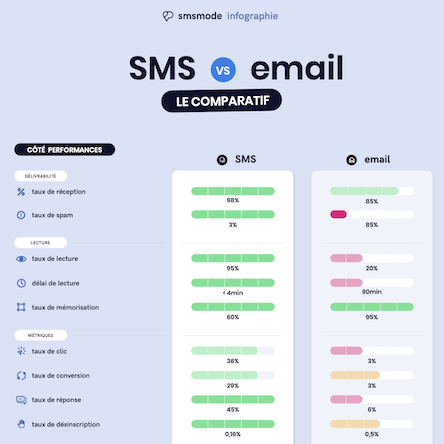Share :
Introduction
Measuring marketing performance is fundamental to understanding the effectiveness of your actions and maximizing your ROI. In this respect campaigns SMS are no exception, and include specific Key Performance Indicators (KPIs) such as delivery rate, open rate and click-through rate (CTR), which need to be known and analyzed. Not only do they enable you to measure the effectiveness of your communications, they also enable you to identify optimization opportunities to ensure that your messages reach the target audience and provoke the desired engagement.
Defining a KPI
A KPI, or key performance indicator, is a quantified figure that reflects the extent to which an objective has been achieved. These KPIs can vary according to what you want to measure: the growth of your contact list, the sales generated by your campaigns, customer engagement, etc. KPIs must be SMART, i.e. Specific, Measurable, Attainable, Realistic and Time-bound. For example, a SMART KPI might be: increase the conversion rate of my SMS campaigns by 10% in 6 months.
The importance of KPIs in campaigns SMS
SMS marketing is a highly effective lever for companies. It's short (160 characters), instantaneous (average reading time 90 seconds) and personal (perceived as a private message). SMS has an opening rate of 98%, a response rate of 45% and a conversion rate of 29% on average. These figures are well above those of other channels such as e-mail, which has an average open rate of 20%, a response rate of 6% and a conversion rate of 3%.
These specificities mean that the choice of indicators must take into account the nature of SMS and its impact on the customer. Properly determining the indicators to track enables you to evaluate the performance of a campaign and optimize future ones based on customer feedback. They also enable you to improve the benchmark KPI: return on investment (ROI), by comparing the cost of sending SMS to the sales generated by the campaign.
Which indicator should you choose for SMS Marketing?
To determine which indicators to track, you first need to define your marketing objectives. What is the aim of your campaign? Building customer loyalty, encouraging them to buy, informing them, getting them to take part in a competition, etc.? Next, you need to identify the indicators that will enable you to measure the effectiveness of your strategy. For example, if your objective is to build customer loyalty, you can use the retention rate, the reactivity rate or the churn rate.

The 6 main KPIs of the SMS
What are the main KPIs to track for your campaigns SMS ? How do you calculate and interpret them? What factors influence these indicators?
Discover the 6 essential KPIs of SMS.
Delivery rate: 1st performance indicator
The delivery rate is the first indicator to take into account. It corresponds to the number of SMS received in relation to the number of SMS sent. It is calculated as follows:
Delivery rate (%) = (Number of SMS delivered / Number of SMS sent) x 100
The delivery rate is essential, as it reflects the quality of your contact base, the routing capacity of your SMS platform and the availability of the network. If your deliverability is low, it means you're losing part of your audience and wasting resources. A good delivery rate is over 98%.
- Regularly clean up your database, deleting incorrect, inactive or unsubscribed numbers.
- Choose a reliable platform that complies with quality and safety standards, and has direct routes to operators.
- Adapt the content of your SMS so that it doesn't appear as potential SPAM by avoiding excessive capitalization, special characters or excessively long links.
Open rate: a measure of initial commitment
The open rate is the percentage of SMS opened by recipients in relation to the number of SMS delivered:
Open rate (%) = (Number of SMS opened / Number of SMS delivered) x 100
The open rate is a measure of your contacts' initial engagement. It indicates whether your message has aroused interest and curiosity. It is influenced by the relevance of your message, the time and day it was sent, and the sender's name. A good open rate is over 95%.
To improve it, you can :
- Segment your audience, sending personalized messages tailored to your customers' needs, preferences and behaviors.
- Choose the right moment,taking into account the context, seasonality and buying cycle.
- Use a sender name that inspires confidence by being clear and recognizable.
The click-through rate (CTR): evaluating the effectiveness of Call-to-Actions
The click-through rate (CTR) represents the proportion of messages that have generated a click on a link, in relation to the number of SMS opened:
Click-through rate (%) = (Number of clicks / Number of SMS opened) x 100
The click-through rate is an evaluation of the effectiveness of your Call-to-Action (CTA). It indicates whether your enriched message has prompted your recipients to take action, by directing them to your website, application, product sheet, form, etc. It depends on the quality of your offer, the clarity of your call-to-action and the trust placed in your message. It depends on the quality of your offer, the clarity of your call to action and the trust placed in your message and URL. A good click-through rate is above 10%.
There are several factors to take into account to improve this rate:
- Propose an attractive offer that adds value and creates a sense of urgency or exclusivity.
- Write a clear , concise call to action , clearly stating what you want your customer to do, and encouraging them to act quickly.
- Use a short, personalized link, adapted to the SMS format, which is easy to read and inspires confidence.

Conversion rate: the culmination of marketing efforts
The conversion rate measures the percentage of SMS that have resulted in the achievement of the desired objective, such as a purchase, registration, download, etc. It's the culmination of your marketing strategy. It indicates whether your SMS campaign has achieved its objectives and generated sales for your company.
Its calculation is as follows: Next :
Conversion rate (%) = (Number of conversions / Number of SMS delivered) x 100
Many factors influence it, such as the added value of your proposition, the ease of the buying process and the recipient's trust in your brand. A good conversion rate is above 5%. With SMS it can be very high.
Here are some tips on how to improve it:
- Align your proposal with the customer's needs and expectations with an adapted offer.
- Simplify the conversion process, by reducing the number of steps, optimizing navigation and offering a variety of secure payment methods.
- Reinforce the confidence of your recipients, by providing them with clear, transparent information.
Churn: understanding audience loss
The unsubscribe rate corresponds to the number of SMS s that triggered an unsubscribe request in relation to the number of SMS s delivered:
Churn rate (%) = (Number of churns / Number of SMS delivered) x 100
It's an indicator of customer satisfaction with your marketing. If your mailings are perceived as useful and interesting, it will remain close to zero. On the contrary, if your communications are perceived as intrusive, inappropriate or undesirable, it could soar. A good churn rate is less than 1%.
Some best practices to reduce your churn rate :
- Respect the consent and preferences of your contacts, by asking for their explicit agreement to the sending of SMS.
- Make sure your message frequency is correct and/or allow subscribers to choose their own frequency.
- Clearly indicate how to unsubscribe, and make it quick and easy.
- Make sure your communications offer a benefit, by rewarding loyalty and soliciting customer opinions or participation.
R.O.I.: the king of KPIs
ROI (for Return On Investment) is a way of assessing the profitability of an investment, taking into account the money invested in a campaign and the money earned as a result. It's the most interesting KPI for an entrepreneur, because it lets you know whether an action is profitable, which is the basis for commercial success.
The R.O.I. formula
R.O.I = (revenues - costs) / costs x 100.
The ROI of SMS is influenced by a number of parameters, such as the place of SMS in your strategy, the quality of your mailing list, the message, the offer and your user experience. The average ROI for SMS is over 3000%.
To optimize the ROI of your campaigns SMS :
- Determine all the costs associated with your communication SMS.
- Analyze all SMS
- Optimize your strategy with the knowledge you gather
60 original examples for high-ROI campaigns.

Analyze and optimize your campaigns using the KPIs of the SMS
- Collect data, using the appropriate tools, such as your SMS platform, a CRM, or a web analytics tool.
- Process data, cleaning it, structuring it and aggregating it to make it usable.
- Analyze your results to extract relevant information.
- Act on the data, turning it into recommendations for improving your campaigns.
This process needs to be repeated regularly, to ensure continuous improvement of your campaigns, and to adapt to changes in the market and your customers' needs.
Analyze and optimize your campaigns using the KPIs of the SMS
Pitfalls to avoid in interpretation
Interpreting KPIs is not an exact science, and can be subject to error, bias and misunderstanding. To avoid these pitfalls, adopt a critical and objective approach, respecting a few basic principles:
- Don't focus on a single KPI: take into account all the indicators to get a global and coherent vision.
- Compare comparable data: make sure you use the same criteria, methods and sources to avoid distortions and inconsistencies (A/B testing).
- Don't confuse correlation with causation : check whether the observed links between variables are really significant.
- Avoid hasty conclusions: rely on sufficient, reliable and representative data to avoid generalizations and approximations.
- Take into account the context: such as seasonality, competition, or events that can influence the results of your campaigns.
By adhering to these principles, you'll be able to interpret your results more accurately and avoid analysis errors that could harm your performance.
Discover all the communication possibilities offered by mobile mass marketing campaigns.

Conclusion
SMS KPIs are important to your success, as they enable you to identify the strengths and weaknesses of your SMS campaign. They enable you to test and validate hypotheses through data-controlled experiments, as well as learn about your customers' journeys, profiles and behavior. With them, you have all the keys you need for effective, relevant communication. Now all you have to do is exploit their findings for your future campaigns SMS.
Try out our SMS platform and benefit from 20 free test credits, with no obligation.

